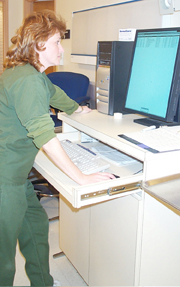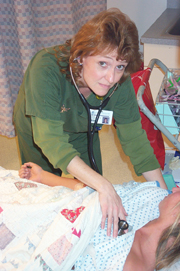Mother, daughter, writer andER Doctor in the Fast Track
by B.C. Phillips
There’s no pulse whatsoever in the man’s leg. It’s blue; it’s cold.
“He’s going to lose his leg if I don’t get Vascular on the phone,” says Dr. Joan Lehmann, physician in the Fast Track Emergency Room of Baltimore-Washington Medical Center.
But for whatever reason, Vascular — short for Cardio-Vascular, the department that would conduct the needed surgery — isn’t answering the phone. The elderly hard-of-hearing veteran whose leg is being prodded and poked by a team of doctors, nurses and techs doesn’t understand the hold-up. All he knows is the unbearable pain in his hip that led him to dial for the ambulance.
Meanwhile, it’s 11:25am and already the lobby and hallways are full of people waiting to see Lehmann, the other physician on duty or one of their hard-working physician’s assistants. That many of these patients don’t belong in the emergency room is by now a given, and beside the point.
Dr. Lehmann takes this all in stride, as she has learned to do. Seven years in an urban ER has undoubtedly toughened the Lothian native, but Lehmann, who now makes her home in Pasadena, remains reflective. What most of her Fast Track patients don’t know about their doctor is that she works a second shift on another fast track, as a new writer.
Country Girl in the City
If you are a careful Bay Weekly reader, you’ve seen Lehmann’s byline. She has been contributing homegrown Bay Reflections since May 2004, recalling fish-hook flesh wounds in the ER and unconventional crabbing methods with an agile humor (http://bayweekly.com/year04/issuexii20/reflectxii20.html and http://bayweekly.com/year05/issuexiii30/reflectxiii30.html).
Lehmann brought good news to this past Bay Weekly Christmas party: her 1,000-page memoir, Don’t Move Rosa, had just come under contract with a reputable literary agent, who will shop the book to prospective publishers. The memoir’s title refers to the 800-pound housebound woman Lehmann cared for during a year of her medical residency. Lehmann’s initial disgust with the assignment turned into a deep compassion that continues to enrich her medical practice.
“This woman lived a life of anonymity,” says Lehmann. “She’s buried in a grave with no tombstone. But she was a special person. And I think there are certain stories to be told about special patients.”
Lehmann also writes short stories she describes as “kinda Wonder Years: my childhood from a 10-year-old’s brain.” Growing up on a Lothian farm made for colorful tales. Her father, for example, used to fire his gun at stray cats.
This rural upbringing pushed her toward medicine in contradictory ways. On the one hand, the young Lehmann saw medicine as an escape from the small-town world of Southern Anne Arundel County. Yet she took as her original role models the country doctors whose office she passed everyday on the bus ride home from school: “Dr. Wirth, Dr. Wilson and Dr. Jones,” she recalls.
Graduating as Southern High’s 1981 valedictorian earned her a full ride to the University of Charleston, followed by medical school at Marshall University, both in West Virginia.
Now she works on the Fast Track, the first tier of a two-tier ER system meant to deal with the increasing number of ER patients. The Fast Track, or minor ER, handles routine patients and begins the work-up on critical cases that are eventually transferred to the main ER.
Most days, both ERs seem overrun. Even when she was dreaming of escaping Lothian, Lehmann didn’t expect to end up here.
“It’s funny how I grew up in such a small town on a farm with peace and quiet, nothing around at night but the crickets, and now here I am in this loud, chaotic ER country girl in the city.”
The country girl lives on in Lehmann’s roles as mother and daughter. She and her two children, 10-year-old Jenna and seven-year-old Lukas, share their home with Lehmann’s mother, Barbara. Having her around is “a wonderful thing,” says Lehmann, for her and the kids.
“She tells the kids stories of when she was little and teaches them how to cook and crab and swing a baseball bat. She’s my period expert when I’m writing about the early- and mid-20th century. Occasionally I get to teach her something. We all need each other.”
Lehmann has always found support in her mother.
“She is just as happy about me raising strawberries, painting the house, cooking supper — or writing a book for that matter,” Lehmann says, “as she is about my becoming a doctor.”
State in Crisis
The elderly man with the pulseless leg has finally been moved to the Vascular Department. Lehmann’s next patient is a young Baltimore woman complaining of a toothache. She has no medical or dental insurance; the ER is her only hope of professional care.
They get a lot of patients from southern Baltimore at this Glen Burnie ER.
“Baltimore hospitals are so overloaded that the wait can be ridiculous,” explains Lehmann. “But if they drive 10 minutes to this nice little community center they can be seen more quickly.”
Lehmann instructs the woman to open wide. Observing from behind, I see molars decayed to the root.
“Her teeth are deplorable, absolutely deplorable,” says Lehmann once we leave the room. She had questioned the woman about her oral hygiene habits but didn’t push the matter.
“When I get the teenagers in here who needs a pregnancy test, man, they get the whole spiel,” Lehmann assures me. “But at 33 years old, with half her teeth rotten, it’s too late.”
Today a significant number of people come to the ER only because they lack medical insurance and have no place else to go for treatment. But rising insurance costs affect doctors as well as patients. The old ideal of the country doctor that inspired Lehmann is no longer realistic in a world where, in Lehmann’s words, “business has taken over medicine.”
“Maryland is in a state of medical crisis because of rising malpractice suits, decreasing compensation from third parties and increasing overhead costs,” she says.
Her concerns were echoed by every doctor and nurse I spoke with at Baltimore-Washington Medical Center. An increasing number of malpractice suits have driven the cost of doctors’ liability coverage through the roof, they say. The insurance costs of opening that country doctor’s office are now too high for most doctors to bear by themselves or in small numbers. This explains the rise in large group medical practices.
Lehmann spent several years with such a practice but disliked the controlling atmosphere. The ER opportunity was attractive because it offered the safety net of a big hospital: more nurses and specialists, better equipment and strong financial backing.
Still, the money is not what it used to be, and Lehmann says even hospital doctors are wasting time and money on unnecessary tests, drugs and referrals for patients just to protect themselves from possible suits.
What’s the solution? Lehmann favors a two-armed approach: peer review of malpractice suits, combined with caps on malpractice awards.
“Malpractice cases need to be screened for viability by a panel of doctors and nurses, not by lawyers,” says one young nurse during an animated lunch conversation. The whole room sings its agreement.
One Woman, Two Arts
The ER also gives Lehmann a better chance to practice what she calls “the art of medicine.” There are multiple ways to respond to a given set of symptoms. With a constant stream of diverse cases needing her immediate attention, Lehmann has ample opportunity to put her hard-earned experience and ingenuity to work.
An elderly woman, dressed for company in blouse and skirt, is brought in on a stretcher after a fall down the stairs. There is a lump on the crown of her head big enough to be seen from across the room, a real goose egg.
At first, there is little cause for concern. The sturdy-looking woman is alert and oriented, showing no change in mental status. There are no signs of broken bones. Even so, Lehmann orders a CT scan of the head to see what’s beneath that lump, and the results show bleeding within the woman’s skull, a potentially fatal condition called subdural hematoma.
Just as we get these results, the nurse reports the woman has started to show signs of disorientation. Her speech is slurred; she is becoming confused.
Lehmann shakes her head. “I had a neurologist tell me one time, ‘blood in the brain, never the same.’” The woman will have to go up to surgery immediately.
But Lehmann can’t get the woman’s doctor on the phone to obtain a crucial medical history. It’s 1:15pm. Lehmann has been on the floor since 7am without a break.
“They’ve transferred me seven times for this patient. I’m sitting here on hold, charts are piling up, and I haven’t been to lunch yet,” she says, phone in hand. The tone in her voice tells me, “This is typical.”
Somehow, Lehmann can go home, put all this to the side, and write.
Don’t Move Rosa took her three years to finish. Her second book, a 50,000-word novel finished New Year’s Eve, took her a mere eight weeks. Tentatively titled Our Heaven Below, it tells the story of an Eastern Pennsylvania coalminer of Irish ancestry.
As if that wasn’t enough — she still has to make revisions on the first two books, and sell them to publishers — Lehmann is now working on compiling her farm stories into a second memoir.
“Patients slam through here so quickly. Writing is a sort of therapy for me, a way of affirming that what I’ve done is worth something.”
One of Lehmann’s gifts, I have noticed during my day with her, is her ability to find the humor and irony in even the most difficult and wearisome of circumstances. She has an eye for a good story. It is in the quiet hours, away from the chaos, that she works these memories into words.
I ask her if she has ever written about her experiences in the ER.
“When I leave here I’ll write about this. It’s too close right now.”
B.C. Phillips has some familiarity with emergency rooms, having worked and volunteered as an EMT post-college. He recently left Calvert County, where he was born, for a different sort of harbor life in Brooklyn, New York.




